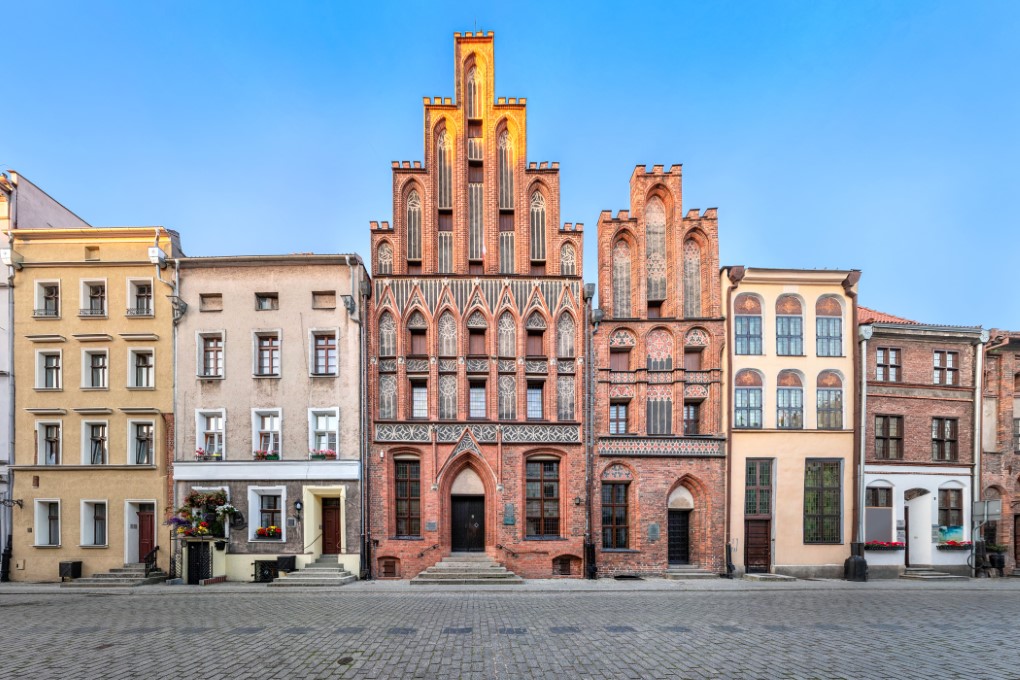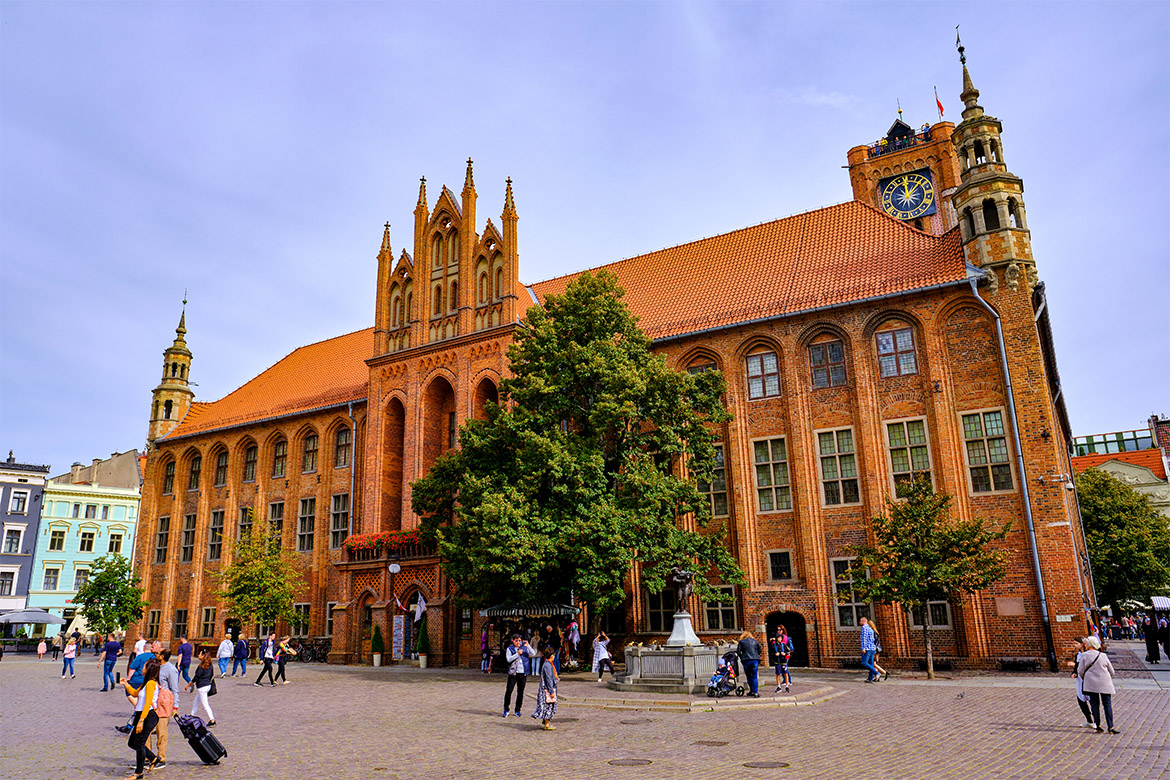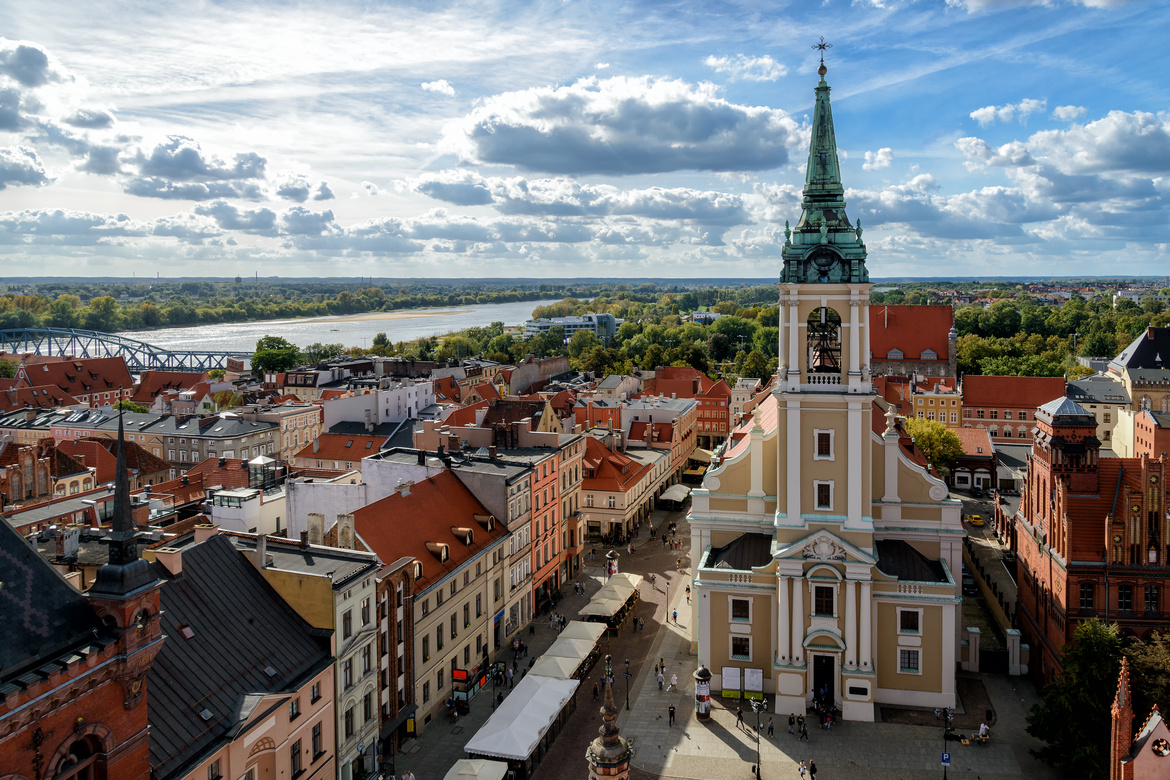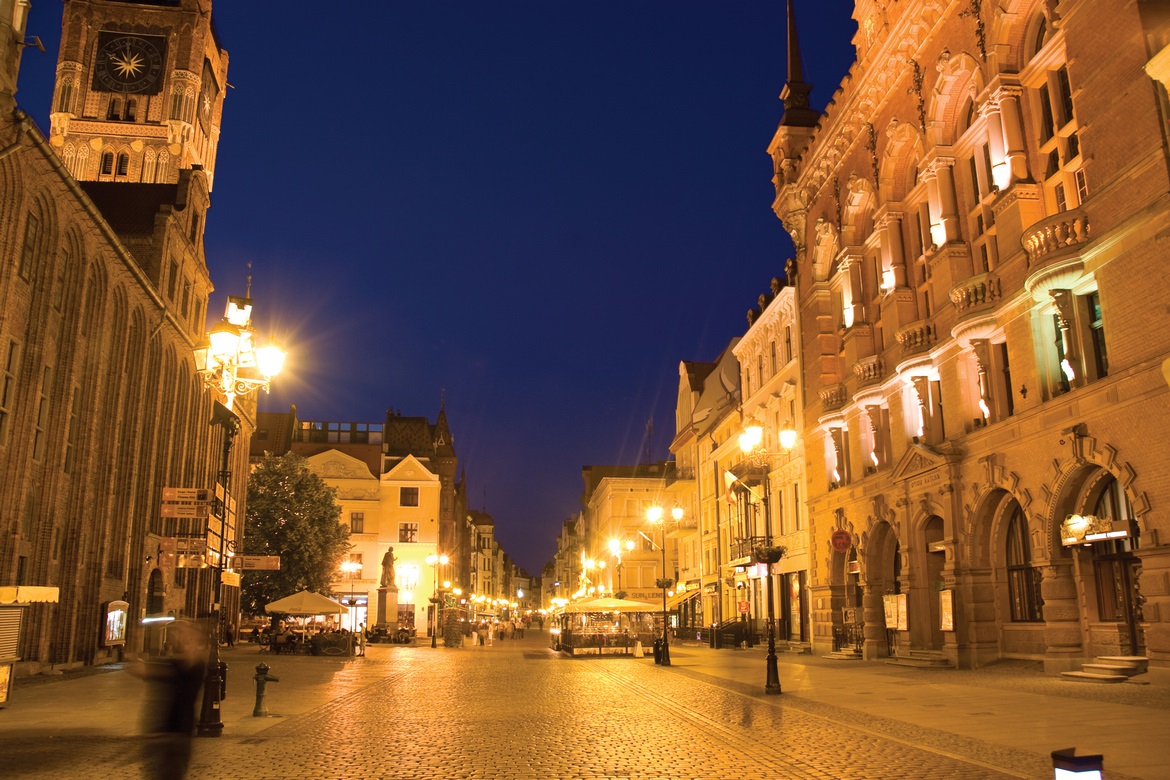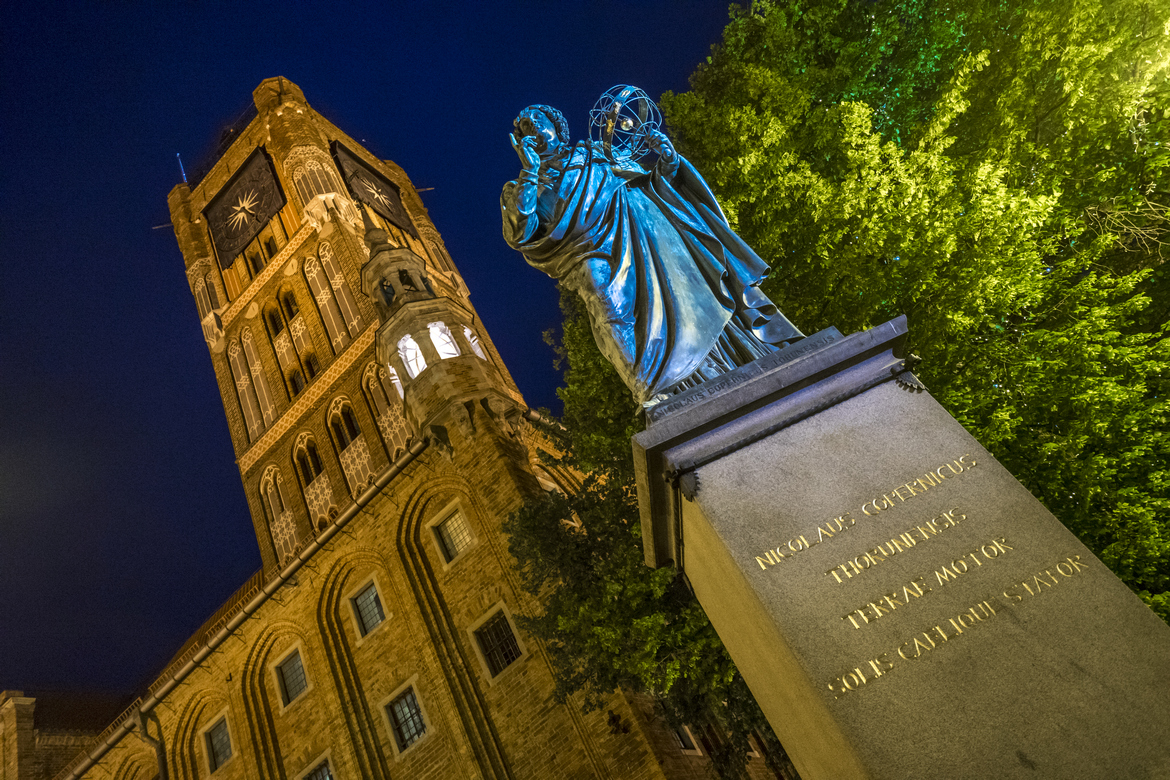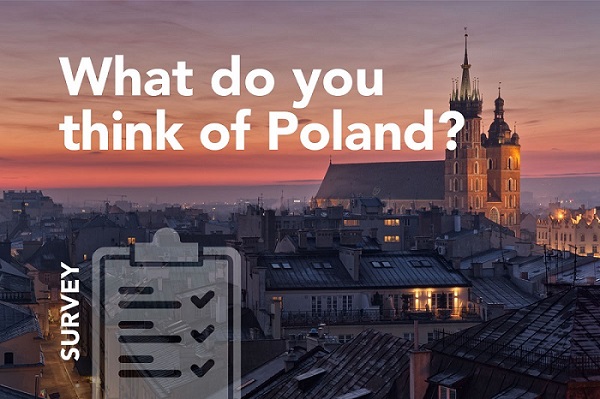Toruń
Toruń
Dynamic, historic and utterly charming, with a spectacular medieval town that is a UNESCO World Heritage Site. As one of Kujawsko-Pomorskie province’s two capital cities, this is now one of the most important cultural and tourist hubs in Poland. If you haven’t visited Toruń yet, it’s time you did…
A City that Shines
It’s hard to describe Toruń better than Polish chronicler Jan Długosz did back in 15th Century. Despite how much it’s grown and changed since his time, even back then it was clearly special: “With its decorative buildings and brick tiles covering its roofs, Toruń shines so wonderfully that few towns can match its beauty and magnificence”. The town was established in the 13th Century by Teutonic Knights – but somewhere else! The reason it was later moved, according to the Teutonic Order’s chronicles, was constant flooding. Within a short time, two towns had developed: The Old and the New, and the Teutonic Knights built their castle very logically between the two.
City of Angels, Peace…
Today the presence of two historical market squares serves a reminder that two towns once stood here. In the middle of the Old Town Square stands the monumental Town Hall, and it is an absolute showstopper. Above its gate you can see the city’s symbol: an angel holding a key and a gate with three towers. If you’ve got a keen eye, you’ll notice that in the gate is a door, which is half-open, and half-closed. Why? Many ask. Well, the explanation is actually rather simple: the city is closed to cruel enemies, but open to guests.
With good reason, it’s also known as a city of peace: two peace treaties ending Polish-Teutonic wars were signed right here in Toruń, in 1411 and 1466. Under the latter treaty, Toruń became a town belonging to the Kingdom of Poland. As the chronicler wrote at the time, “On Sunday the nineteenth day of October, after fulfilling and confirming the agreement on perpetual peace whose terms and provisions were composed over several days, … King Casimir and Master Ludwig came in person to the Toruń market with large retinues of gentlemen. When they had greeted each other in a friendly manner, silence was ordered, and Rudolf, the papal legate, announced the fullness of the agreement on perpetual peace between Casimir, King of Poland, and his kingdom on one side, and Ludwig, Prussian master, and the Order on the other, successfully concluded”. [based on Jan Długosz’s Annals]
…and many bizarre animals
There are animals all around this city, involving several legends and traditions. Near the Town Hall, you’ll find frog fountain (not real ones). Don’t leave without giving their backs a stoke – it’s a small price to pay for, according to legend, happiness. Why risk it, right? Standing near the fountain, look upwards and around until you spot the black cat, on the roof of one of the tenements. It’s said to be the defender of the city. Then there’s the donkey. Yes, donkey. Many a visitor is surprised to stumble upon the figure of a donkey standing near the market square. It may look cute, but its symbolism is actually quite dark: it’s a reference to a former punishment site. In the olden days, unruly guards were seated on a donkey’s back, with a metal rod to inflict pain and weights tied to their feet to make the punishment even worse. A statue with a nicer story is found on the other side of the square. Filuś the flappy-eared dog, sits playfully next to a lamp post, its master’s bowler hat in its mouth. They say that if you stroke its head, you’ll get wiser, and if you grab its tail, you’ll be lucky in love. Why choose? Do both!
Gothic, Gothic Everywhere
Toruń’s strategic location on the River Vistula massively impacted its economic development, right from the very beginning. Toruń was a member of the Hanseatic League, and traces of that membership are visible along Szeroka Street, in which the coats of arms of cities Toruń traded with have been craftily embedded. In the past, the city’s wealth was evident by looking at its defensive walls, town halls, burgher houses and numerous churches. Today, many of these relics of former glory remain for you to admire when you stroll around historical Toruń. Not all the town gates, walls and churches have survived the ravages of time, understandably, yet what is left is more than enough to captivate even the most demanding of visitors.
The Birthplace of Nicolaus Copernicus
Once upon a time, a merchant from Kraków arrived in this wealthy town. That man was Nicolaus Copernicus, the father of four children born in Toruń, including a son named after him who went on to become one of the most important names in history. It remains a great mystery, even to this day, in which house exactly the great astronomer was born. But there’s no mystery surrounding the font he was baptised in – that stands in the Copernicus Chapel at St. James’ Church. If you embark on a route that traces the life of the famous astronomer, the Nicolaus Copernicus House museum is an absolute must. Part of the exhibition is housed in a stunning red-brick tenement that actually belonged to the Copernicus family.
From Famous Astronomers to Famous Gingerbread
Toruń is also well-known for its sublime gingerbread, which forms an important part of the city’s heritage. It is here, under the watchful eyes of master gingerbread bakers, that visitors to the city can obtain knowledge once kept very secret. Surrounded by the aroma of spices, you are given the chance to create gingerbread to take home as a souvenir (or, more likely, eat before you leave!). A few places invite you to make this Toruń treasure for yourself, including the Museum of Toruń Gingerbread and the Living Museum of Gingerbread. See? It’s that important, it has museums dedicated to it. The oldest known recipe for Toruń gingerbread actually comes from a medical book; if you needed an excuse to tuck in, now you have one!
Legacy of Knights
Toruń is a former fortress. Its medieval walls featured 12 gates, over 60 keeps and two barbicans. The most famous keep is the Leaning Tower. Didn’t know there was another Leaning Tower, did you? According to one legend, its crookedness was a punishment for a sinful Teutonic Knight. When you visit the tower, here’s what you’re supposed to do: stand under the tower with your heels, back and head touching the wall, arms stretched out in front of you. Whoever can stand like this without wobbling, has a clear conscience. Or so the legend goes, anyway. Today, the oldest preserved section of the historical walls faces out to the River Vistula and features three gates that once lead into the town. In the 17th Century, when Swedish forces were a threat, magnificent bastions were built around Toruń. Two centuries later, the Prussian authorities surrounded the city with a ring of fortifications some 22.5 kilometres in circumference. During the construction of this fortress, around 200 defensive structures were built on both banks of the Vistula, including some 15 forts. They took defending their city very, very seriously! If you’d like to give an unruly child or partner a scare, take them on a tour of Fort IV, where a Prussian soldier will soon show them what’s what!
One attraction you shouldn’t miss are the remains of the Teutonic castle. Built on a horseshoe plan, its construction started way back in the 13th Century, making it the first Teutonic castle on the right bank of the Vistula. Mostly demolished by Toruń’s burghers in the mid-15th Century, it’s a stark reminder of the consequences of the abuse of power. While you’re there you may be told about Jordan the cook. One legend says that the people of Toruń had a helper within the castle, namely Jordan, who climbed the stairs to the top of the tower and gave the signal to attack. Unfortunately, the attackers blew up the tower, and the force of the explosion launched the well-meaning cook into the air, flying all the way across Toruń and landing on one of the gates. Poor Jordan!
A Regal City
Throughout the ages, both in Teutonic and Polish times, Toruń has welcomed Polish kings on several occasions. In late May 1404, during a visit by King Ladislaus Jagiełło, there was quite the drama, documented by Długosz as follows: “And when during those three days King of Poland Ladislaus travelled around the streets of Toruń with the master of Prussia to see the town’s location, a cook spilled dishwater all over King Ladislaus. Arrested on the master’s orders and sentenced to drowning, she was saved by the king’s goodness”. Maybe he wasn’t watching where he was going. No king liked the city as much as Casimir Jagiełło, however, who visited Toruń the most: 16 times to be exact, spending a total of 14 months here.
The Biggest and Best…
In 1500, a bell was hung in the tower of the Church of St. John the Baptist and St. John the Evangelist. Dubbed “Tuba Dei” – God’s Trumpet, it was the biggest bell in the entire Kingdom of Poland at the time. Weighing over seven tonnes, it is two metres high and over two metres in diameter. That is a serious bell! You can get a good look at it by climbing the church tower. Up-close, its size is really rather imposing. From the Vistula side, you can also see the famous “raftsmen’s clock” on the same tower, unique in that it only has one hand.
To really appreciate the city in all its glory, you need to either take a boat tour along on the Vistula, or cross the bridge to the left bank, where there’s an observation deck especially for this purpose. From there, you can take it all in, the vivid orange roofs, the majestic cathedral and the entire silhouette of this beautiful city. This panorama is considered one of the Wonders of Poland, and it’s easy to see why. Recognition for the outstanding universal value of historical Toruń led to it being listed as a UNESCO World Heritage Site on 4th December 1997. If this city wasn’t on your list of places to visit, it will be now!

